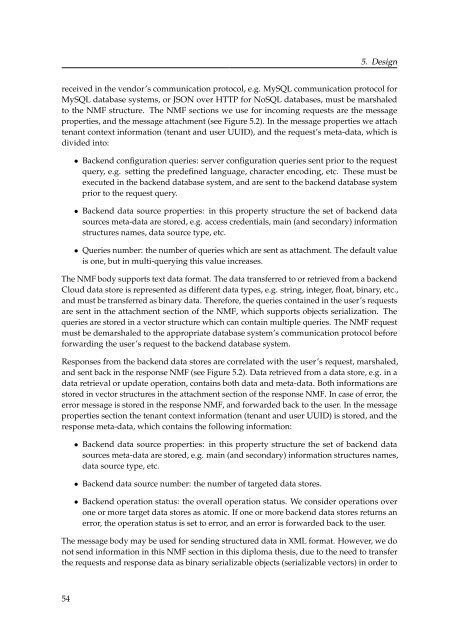Diploma Thesis Santiago Gómez Sáez - IAAS
Diploma Thesis Santiago Gómez Sáez - IAAS
Diploma Thesis Santiago Gómez Sáez - IAAS
You also want an ePaper? Increase the reach of your titles
YUMPU automatically turns print PDFs into web optimized ePapers that Google loves.
5. Design<br />
received in the vendor’s communication protocol, e.g. MySQL communication protocol for<br />
MySQL database systems, or JSON over HTTP for NoSQL databases, must be marshaled<br />
to the NMF structure. The NMF sections we use for incoming requests are the message<br />
properties, and the message attachment (see Figure 5.2). In the message properties we attach<br />
tenant context information (tenant and user UUID), and the request’s meta-data, which is<br />
divided into:<br />
• Backend configuration queries: server configuration queries sent prior to the request<br />
query, e.g. setting the predefined language, character encoding, etc. These must be<br />
executed in the backend database system, and are sent to the backend database system<br />
prior to the request query.<br />
• Backend data source properties: in this property structure the set of backend data<br />
sources meta-data are stored, e.g. access credentials, main (and secondary) information<br />
structures names, data source type, etc.<br />
• Queries number: the number of queries which are sent as attachment. The default value<br />
is one, but in multi-querying this value increases.<br />
The NMF body supports text data format. The data transferred to or retrieved from a backend<br />
Cloud data store is represented as different data types, e.g. string, integer, float, binary, etc.,<br />
and must be transferred as binary data. Therefore, the queries contained in the user’s requests<br />
are sent in the attachment section of the NMF, which supports objects serialization. The<br />
queries are stored in a vector structure which can contain multiple queries. The NMF request<br />
must be demarshaled to the appropriate database system’s communication protocol before<br />
forwarding the user’s request to the backend database system.<br />
Responses from the backend data stores are correlated with the user’s request, marshaled,<br />
and sent back in the response NMF (see Figure 5.2). Data retrieved from a data store, e.g. in a<br />
data retrieval or update operation, contains both data and meta-data. Both informations are<br />
stored in vector structures in the attachment section of the response NMF. In case of error, the<br />
error message is stored in the response NMF, and forwarded back to the user. In the message<br />
properties section the tenant context information (tenant and user UUID) is stored, and the<br />
response meta-data, which contains the following information:<br />
• Backend data source properties: in this property structure the set of backend data<br />
sources meta-data are stored, e.g. main (and secondary) information structures names,<br />
data source type, etc.<br />
• Backend data source number: the number of targeted data stores.<br />
• Backend operation status: the overall operation status. We consider operations over<br />
one or more target data stores as atomic. If one or more backend data stores returns an<br />
error, the operation status is set to error, and an error is forwarded back to the user.<br />
The message body may be used for sending structured data in XML format. However, we do<br />
not send information in this NMF section in this diploma thesis, due to the need to transfer<br />
the requests and response data as binary serializable objects (serializable vectors) in order to<br />
54

















